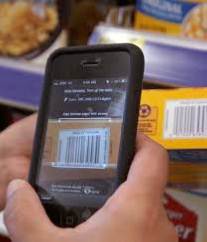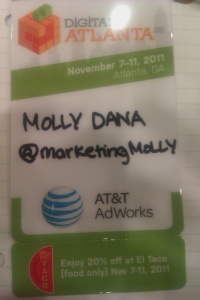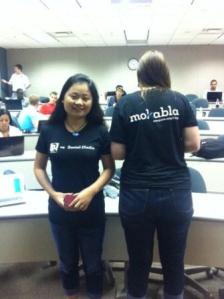Event: Social Media CRM and ROI
Speaker: Alex Avendano Company: Arke Labs
Venue: Hudson Grille
Notes: Day 4 of Digital Atlanta, Social Track.
Social CRM and ROI is something I am really interested in (checkout my Marketing 2.0 Thesis in box.net section on right) so this event was one of my highlights of the conference! My notes from this session were pretty rough, so I borrowed heavily from the powerpoint he used while presenting. I must cite this fact because I don’t want to be accused of plagiarizing!
“Don’t be scared of social media, embrace it as a tremendous opportunity.”
What is Social CRM?
According to Alex it is “an implementation strategy that provides additional, relevant, and social data to sellers, marketers, and decision makers in an effort to improve ROI of multiple aspects of the business.” The basic principles of SCRM are people, platform, product, and process.
- People – your community of users and your internal decision makers
- Platform – Social media outlets tied to your SCRM system
- Product – Combination of tools you utilize
- Process – Standards and protocol implemented to manage social
Traditional CRM was a process controlled and initiated by the business – information was clouded because it had to be updated manually by the seller, and the information was basic, simple, and static. As can be expected Social CRM is a dynamic process that is influenced by the customer – it does not require manual inputs, the information is robust, and there are multiple company touch points. Social data has given companies the opportunity to gather individual consumer insights, and to respond to that information quickly and on an individual basis. This information can be used to drive PR & Marketing communications, to grow sales, to develop products and to improve customer service.
Planning: Preparing for SCRM
There is no one size fits all approach. When preparing to implement SCRM – as with any strategic planning – it is critical to understand the core value drivers of your organization and how SCRM fits within them. In the planning phase Alex recommended a list of questions to ask:
- Who are all the different people that need to be involved?
- What are our priorities and goals?
- What does your platform stack need to look like?
- What does your product stack need to look like?
- What are the right processes that need to be put in place?
- How are you going to measure return and constantly improve?
To properly answer these questions it is important to “involve the right people” – form committees and teams and have an open planning process. Additionally determine the most important goals by department for your SCRM plan. Knowing the answers to these questions, and the goals of the organization as well as departments will help you to determine the most suitable platform, product, and processes for your strategic objectives. Process and structure are keys for social CRM success.
SCRM services to check out are – Sitecore CEP, Broadlook, and Click Dimensions.
Campaigns – Focus on your goals, focus on iterations.
- Campaigns should boost results towards goals, in-line with social lifecycle
- Iterative approach (iteration feedback loop pictured)
- Discovery Driven Planning
- Consider A/B testing
Every organization has its own understanding of ROI and its own ROI goals. It is important to track multiple different metrics that will lead to conversion.
- Value of cost savings – gains in productivity, testing, development
- Valuing social assets – CPM model vs. book value
- Valuing conversion activities – measure each step toward the bottom line
- Valuing bottom line effects – sales
Alex also offered up an alternative viewpoint from Avinash Kaushik in which he values converstion, amplification, applause, and economic value (reminds me of Klout or Peer Index).
- Conversation = Audience comments per post
- Amplification = Shares per post
- Applause = likes per post
- Economic Value = Sum of Short and Long-term revenue and cost savings
Basically ROI is a multifactor equation, that depends on you. Some tips he offers:
- If you have the appropriate data use IRR, CLV, and NPV
- Don’t let ROI dominate your strategy, it’s not all tangible
- Measuring impression value is easy, what about engagement value? Or the value of an integrated system that automates engagement?
- Measuring returns in the face of change and uncertainty
- Get started now, figure it out along the way, don’t play catch up.
- Start with a plan
- Get everyone involved
- Find outside support.
Really looking forward to hearing Alex speak again, hopefully in Athens!







